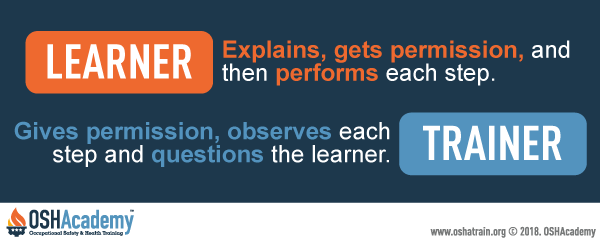On-The-Job Training Strategy
Step 4. Learner tells and does: The trainer has the trainee do it. The trainee performs the procedure but remains protected because the trainee explains and gets permission to do the step before proceeding to do it.



Step 5. Conclusion: Recognize accomplishment - "Good job!" Reemphasize the importance of the procedure and how it fits into the overall process. Tie the training again to accountability by discussing the natural and system consequences of performance.
Step 6. Document: Training documentation should be more than an attendance sheet. Be sure to include the information below to properly document (certify) training in specific safety procedures and practices. Include all of the following even though OSHA rules tell you all that's required is name, subject, and date.
- Trainee's and trainer's name
- Date of training
- List subject(s) being trained - procedures, practices, related policies, rules, etc.
- Certification - trainee and trainer signatures
- Trainee statement of understanding and intent to comply
- Trainee statement that he/she was provided opportunity to practice
- Trainer statement that testing of knowledge and skills was conducted
- Trainer statement that student demonstrated adequate knowledge and skill
Step 7. Validate: After the OJT session concludes, evaluate the employee through observation and questioning to ensure they have gained the necessary knowledge, skills, and abilities (KSAs) to perform the task safely on the job.
Knowledge Check Choose the best answer for the question.
2-6. To validate on-the-job training has been successful, be sure to _____.
You forgot to answer the question!
